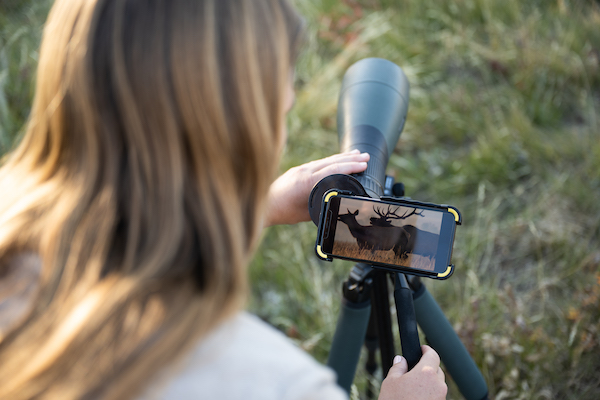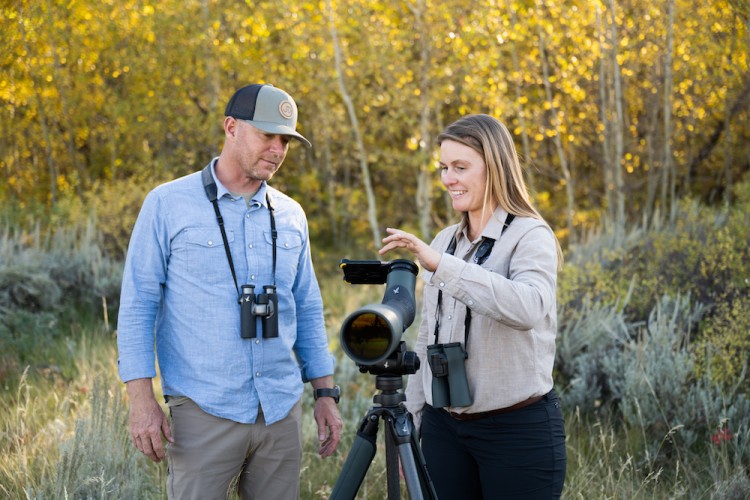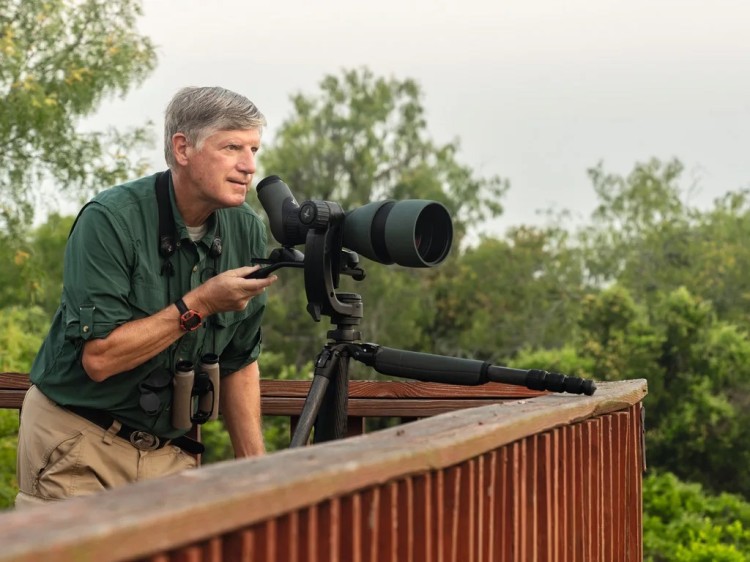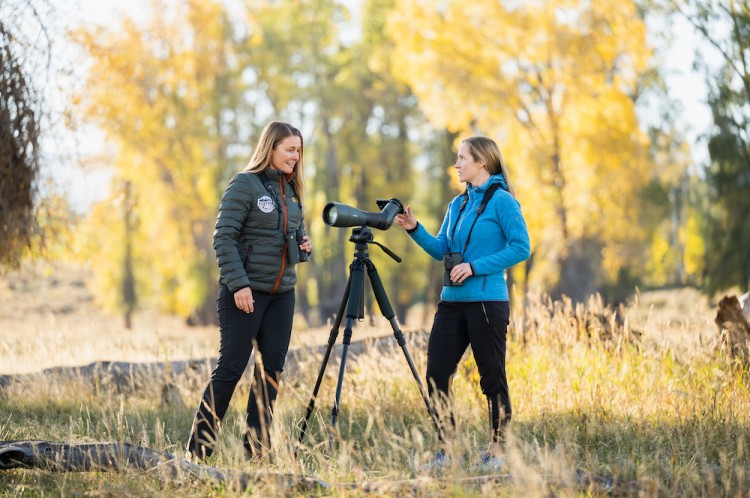Digiscoping Workshop with Swarovski Optik

2023 Dates: This workshop is only available once a year, so book now!
May 27-June 1
As wildlife-viewing optics have improved—leading to clearer, crisper images in a user's binoculars and spotting scopes—there has been a huge growth in the relatively new photography art of digiscoping. If you've ever wanted to learn how to take beautiful photos through your own optics, this workshop is for you!

What is Digiscoping?
“Digiscoping” is the general term that describes taking photos through a spotting scope. The type of cameras used in digiscoping can range from a top-of-the-line DSLR / Mirrorless camera to an ordinary smartphone, and the specific camera / adapter / scope combination used will give magnifications equivalent to a 1000mm to 3000mm lens (or more), giving truly Super Telephoto results!
The advantages of using a spotting scope for high-magnification photography are that the required equipment is smaller and more lightweight than traditional Super Telephoto lenses, has a greater magnification range, and is waterproof and more rugged than a Super Telephoto lens. Plus, you get to VIEW through the spotting scope, meaning you can focus on the experience of wildlife-watching without getting distracted by the nuances of camera settings.
This beginner-to-intermediate digiscoping workshop is designed to welcome new users to the space and work on tips and tricks to maximize your experience when photographing wildlife in their natural habitat. We will be using Ollin's top-of-the-line phone cases and adapters, and all participants will receive their very own Ollin case and adapter fit to their specific phone. Ollin's adapter fits seamlessly onto the eyepiece of our Swarovski Optik spotting scopes—as well as numerous DSLR cameras—and Ollin's phone case uses magnetic technology to snap into place and give you an crystal clear view of your subject on your phone's screen. It doesn't get much better than this!
We are partnering with digiscoping expert Clay Taylor, from Swarovski Optik, to teach participants in the art of digiscoping. Clay has this to say about his favorite form of photography: “Digiscoping has evolved rapidly in the past few years, with new cameras, adapters, spotting scopes and accessories making the process a lot easier and more fun, at the same time yielding better results than ever before.”

About Clay Taylor
Clay began photography in the 1970s, first with race cars and then birds and wildlife, using a Nikon FTn Photomic 35mm camera and various telephoto lenses from 200mm to 800mm. His favorite was the old 500mm f/8 Reflex-Nikkor, as it was lightweight, compact, and portable.
He started working for Swarovski Optik in 1999, attaching his film cameras to the HD Spotting Scopes and amazing customers with the results. The rapid rise of the digital camera hooked him early in 2001. Using the power of the spotting scope multiplied by the zoom power of the Nikon CoolPix 990 digital point-and-shoot camera was a game-changer for wildlife photography.
The advent of the smartphone featuring cameras that could record great still and video images further changed the digiscoping world, and a few years later the Swarovski Optik TLS APO system allowed DSLRs and Mirrorless ILC cameras to do scope photography with no hassle or complicated setup. Clay currently uses on his spotting scope: an iPhone 14 Pro Max, Olympus E-M1 mkIII, Pentax K3, and Sony a7III, and the spotting scope might be anything from the ATX 65mm Modular to the STX 115mm Modular system scope. He's excited to share his skillset—which has been honed and refined for years—with all workshop participants.
Workshop Itinerary
2023 Dates: This workshop is only available once a year, so book now!
May 27-June 1
This workshop will begin in Jackson, WY, where we will host a welcome dinner and orientation. We will go over digiscoping gear as well as optical equipment that we will be using, and we will review the plan for each day’s objectives and lessons.
Our second day will start at 6am, when we will tour through the southern portions of Grand Teton National Park, maximizing wildlife viewing with great opportunities for elk, bison, moose, grizzly and black bears. As we slowly make our way to Jackson Lake Lodge, there are short hikes off the beaten path that we will explore and there will be ample opportunity to explore in greater detail on foot. This is important as it gets us away from the crowds, stretches the legs and allows for more in-depth exploration of the smaller wonders of the park. Participants will have the opportunity to learn the basics of digiscoping throughout the day with Clay Taylor.
On day Three, we will enjoy another sunrise opportunity looking for wildlife in the northern sections of Grand Teton National Park, followed by breakfast in the field as we make our way north into Yellowstone National Park. There, we will explore the Lewis River Canyon and the southern portion of Yellowstone. We will also experience some of the most impressive geothermal activity with many of Yellowstone’s hot springs, geysers, and fumaroles. We will position ourselves to explore Yellowstone’s Northern Range and the Lamar Valley for sunset wildlife viewing and digiscoping opportunities.
Day Four will involve an early morning excursion into the Northern Range of Yellowstone in search of large charismatic megafauna (think: bears, bison, and wolves, oh my!). This area is one of the best wolf viewing locations in the world. There will be many photogenic locations for digiscoping along this pristine wilderness, with ample opportunity to explore on foot in greater detail and get off the beaten path. After dinner in Silver Gate / Cooke City, MT, we will enjoy a classroom session from Clay Taylor and our fellow participants.
On our last full day, we will tour the eastern section of Yellowstone as we make our way back to Jackson. We will visit the Grand Canyon of the Yellowstone River, home to the famous Upper and Lower Falls. These falls are the biggest in the park—the Lower Falls are actually taller than Niagra Falls! As we head south, we will explore and digiscope along the Yellowstone River, where there are many riparian and avian species to observe in great detail. We will end our time together back in Jackson around 5:30PM with a farewell dinner and breakdown of top digiscoping images from the trip.
Day Six is dedicated to personal exploration in Jackson Hole and travel back home!
If this sounds like your ideal trip, click here to reserve your spot! Questions? Call our office at (307) 690-9533. We can't wait to explore with you!
Written by Kelsey Wellington, ETA Naturalist and Social Media Manager. Kelsey holds a BS in Wildlife Biology and an MFA in Creative Writing.














